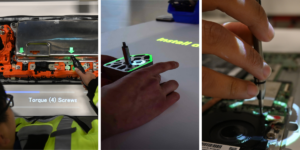
Inflation, scarce talent, and supply chain disruptions are all challenging manufacturers to do more with less. Leading companies are using these challenges as an opportunity to propel themselves forward through the creation of more efficient processes. According to Gartner, “80% of CEOs are increasing digital technology investments to counter current economic pressures.” Strategic implementation of technologies supporting digital manufacturing will be a differentiating factor for companies looking to increase efficiency. Industrial augmented reality (AR) is a proven digital technology to solve these manufacturing challenges, enhancing worker training and onboarding, raising quality control, and improving assembly processes.
Training and Onboarding with Industrial AR Work Instructions
One of the biggest challenges manufacturers continue to face is training new employees or workers who are learning a new process. Traditional training methods can be time-consuming and expensive. With AR technology, however, workers can receive real-time, on-the-job training, reducing the time and cost associated with traditional training methods while also improving the effectiveness of the training.

Projected AR is a unique form of augmented reality that provides workers with step-by-step instructions, displaying graphics, videos, animations, and more directly onto the work surface or a production line. Workers learn new manual processes quickly and efficiently, reducing the risk of errors. For example, a worker learning multiple wire harness assemblies would simply follow the lights rather than attempting to memorize every variation. They would receive standardized and streamlined guidance for every action with projected AR, reducing cycle time and improving quality.
Quality Control at Every Step with Industrial AR Work Instructions
Quality control and inspection are critical processes in manufacturing. Defective or substandard products can lead to increased costs, customer complaints, and damage to the company’s reputation. With projected AR, workers can perform quality control and inspection more accurately and efficiently.
By overlaying work instructions onto physical products, workers quickly identify defects or deviations from the standard in every step. For example, a worker could use LightGuide projected AR to inspect the surface of a product and see a red highlight to attract attention to any errors or incomplete actions. This would allow the worker to identify and address the defect quickly, improving the efficiency and accuracy of the inspection process.
Industrial AR Work Instructions Improve Assembly Precision and Cycle Time
Another area where AR improves manufacturing efficiency is in assembly processes. Complex manual assembly processes can be time-consuming and require a high level of precision. AR can be used to guide workers through these processes, reducing the likelihood of errors and improving efficiency.
Beyond the benefits gained by using AR for training and inspection, utilizing projected AR throughout production gives manufacturers a competitive edge in handling high variation and high throughput. Directing workers with visual cues ensures there is no guesswork and no reliance on memory recall. This is especially useful in high variation environments, as a worker can quickly leverage AR work instructions tailored to the specific assembly sequence with a simple barcode scan.
Additionally, in industries with high throughput like automotive, manufacturers need to keep up with the speed of demand and the need for customization. No matter how many parts need to be produced in a shift, projected AR work instructions can ensure assembly precision in each part with no-fault-forward work instructions.
RELATED CASE STUDY: Hydraulic Manufacturer Achieves Zero Defects with AR Work Instructions
RELATED ARTICLE: 3 Uses of Augmented Reality in Automotive Manufacturing
Industrial AR Work Instructions Ensure Manufacturing Efficiency
As manufacturers continue to face economic pressures, the need for innovative solutions that drive efficiency has become more pressing than ever. By embracing the power of industrial augmented reality, companies can improve their training and onboarding processes, streamline quality control and inspection, and enhance their assembly processes.

By leveraging the real-time, context-specific information of projected AR work instructions, manufacturers can reduce errors, increase efficiency, and achieve a competitive edge in their respective industries. As digital technology continues to transform the manufacturing landscape, those who leverage AR are well-positioned to stay competitive in an increasingly complex, challenging global marketplace.
RELATED ARTICLE: Resilient, Recession-Proof Manufacturing: 3 Strategies to Consider


